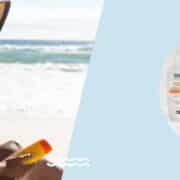Men’s Health Month & The Importance of Skin Checks
- A good, bright light
- A full-length mirror
- A hand mirror
- Two chairs and/or stools
- A brush and/or hairdryer
- Facing the full-length mirror, examine your lips, nose, mouth, forehead, ears, neck, shoulders, chest, arms, underarms, hands, palms, between the fingers, the fronts of the thighs, and the shins.
- Continue by bending your elbows to examine your forearms and the backs of your upper arms.
- Standing with your back to the full-length mirror and using the hand mirror, inspect the back of your neck, shoulders, upper back, and any part of your upper arms that you could not clearly view earlier.
- Continue in this position by scanning your lower back, buttocks, and the upper part of the back of your legs.
- Check your scalp by parting your hair – with a brush and/or hairdryer, if necessary – as well as around and behind your ears.
- While sitting on a stool or chair, prop your feet up and check the backs of your calves as well as the tops and bottoms of your feet, including between the toes.
- Finally, still sitting, use the hand mirror to examine your genitalia and any parts of the buttocks or upper legs you may have missed.
10 Summer Skin Cancer Prevention Tips
- Basal cell carcinoma: The most common type of skin cancer. It generally presents as a raised pink, red, or white patch on the skin.
- Squamous cell carcinoma: This condition is the next most common type of skin cancer after basal cell carcinoma. Squamous cell carcinomas are typically scaly, crusted patches on the skin.
- Melanoma: The rarest and most dangerous type of skin cancer. Melanomas generally appear as dark, irregular spots on the skin.
Why You Should Have a Pre-Summer Skin Check
- Basal Cell Carcinoma: Basal cell carcinoma is a form of skin cancer that is caused by damage to the skin from ultraviolet (UV) light. It is the most frequently diagnosed type of skin cancer and is usually not life-threatening. However, if left untreated, it can cause damage to the skin and can spread to other organ systems.
- Squamous Cell Carcinoma: Squamous cell carcinoma is a category of skin cancer that is potentially dangerous if not treated promptly. Although rarely life-threatening, it can cause serious damage to the skin and surrounding tissue if unaddressed. Squamous cell carcinoma might spread, leading to more serious problems such as lymph node involvement and organ damage.
- Melanoma: Melanoma is a form of skin cancer that can be highly dangerous if left untreated. It is caused when melanocytes, which are the cells that produce pigment in the skin, become cancerous. Melanoma can be deadly if it spreads to other body parts, including the lymph nodes and vital organs.
- Asymmetry. A skin patch, spot, or mole with a jagged or irregular shape is more concerning than a perfectly round spot.
- Borders. Uneven or undefined borders are potentially serious.
- Colors. Inconsistent colors or colors that appear to fade within the spot should be checked.
- Diameter. Spots larger than approximately 6mm should be examined.
- Evolving. Spots that change color, size, or shape.
How Sunscreen Protects Your Skin: Your Burning Questions Answered
- Ultraviolet A (UVA): UVA radiation is most commonly associated with photoaging (wrinkles) and certain skin cancers.
- Ultraviolet B (UVB): UVB radiation has a slightly longer wavelength than UVA. UVB rays are associated with sunburn and especially dangerous forms of skin cancer, notably malignant melanoma.
- Ultraviolet C (UVC): UVC radiation has the shortest wavelength of the three types of UV energy, but UVC radiation is only produced artificially; the ozone layer filters out almost all UVC rays from the sun. UVC radiation is used to disinfect surfaces. It can cause significant damage to the skin and eyes.
Check and Protect in Honor of Skin Cancer Awareness Month!
- Stand in front of a mirror in a well-lit room.
- Be sure to look at the entire body from head to toe, including the scalp, the back of the neck, the back, between the buttocks, and the soles of the feet.
- As you look at your skin, look for any changes in size, shape, color, or texture in any moles, birthmarks, or freckles. Pay special attention to any growths with an irregular shape or color, areas of skin that are tender, itchy, or bleeding, or moles that have changed size or shape over time.
- Take note of any changes that you find, and be sure to mention any changes to your doctor.
- Wear sunscreen daily. Even if you spend most of your day working indoors, you could be exposed to unfiltered UV radiation if you work near a window or have a long drive to work. Wearing a good, broad-spectrum sunscreen (SPF 30 or higher) will shield you from inadvertent UV exposure.
- When it comes to sunblock, more is more! Most people don’t use enough sunscreen. Your face and neck require approximately one teaspoon of sunscreen for thorough coverage. For full body protection, you’ll need at least two tablespoons to shield yourself from head to toe.
- Wear clothes with an ultraviolet protection factor (UPF) of 50+. If it’s not practical to slather your whole body with sunscreen, wearing long-sleeved sun-protective clothing is an excellent alternative. Choose garments with a UPF label to ensure you get the proper protection. Also – don’t forget sunglasses! Choose a UV-blocking, wrap-around pair for maximum coverage.
- Stay in the shade. A shady spot can screen out a significant amount of UV light, but it depends upon the quality of the material blocking the sun and the degree to which you are exposed to indirect light. Dense tree covers provide greater protection than single trees, and structures with side walls offer more protection than shade structures mounted on poles.
October Specials
Sculpsure Targeted Fat Reduction – Zero-downtime fat-reduction treatment to reduce up to 24% of fat in treated area over 12 weeks – Buy 3 treatments for $2095 (same area) get 4th FREE
Fall Repair Treatments:
Calecim Serum – Stem-cell protein enhanced serum for brightening and reduction of fine lines – Buy 3 vials for $189, get 4th FREE
C-The Change CBD Serum (In-office only) – An elegant CBD concentrated serum for AM/PM application – 1000mg CBD – Buy 1 at full price ($89.00), get 2nd at 50% off
June Specials
Father’s Day Special with Shirley – Dermaplaning/Micro-dermabrasion combo with a light peel – Zero-downtime treatment to renew and brighten facial skin & smooth surface – NOW $100, Reg $150
Need Botox? Release those expression lines for a smooth and less stressed appearance – $50.00 off (35+ units)
Need Filler Too? Smooth folds, enhance lips or add volume to cheeks -Additional $50.00 off (in stock filler when treated in the same appointment)
Father’s Day Facial with Shirley
Dermaplaning/Microdermabrasion Facial with Light Peel
Zero-Downtime treatment to renew and brighten facial skin for a fresh & smooth surface. Now $100.00 through Father’s Day. Call and schedule now for the special Father in your life!
May Specials
SculpSure – Fat Reduction Laser Treatment – Additional Treatments/Touch-up – Anyone having previously purchased SculpSure Fat Reduction treatments can purchase another treatment for $595 (any previously treated area)
Get Ready for Mother’s Day – Look your BEST for your special day – Purchase 2 vials filler & add Botox – $10/unit
Renewing Body Lotion – Excellent for dry arms and legs – Now $51, Reg $63
Restorative Eye Complex – Brighten and tighten – Now $57, Reg $72
Contouring Cream – Smooth and tighten, face, neck & chest – Now $57, Reg $72
Traveling Soon? Free & Clear Shampoo for Sensitive Skin – TSA Approved 2 oz size – Now $5, Reg $6
Contact Us
ANAHEIM HILLS OFFICE
Phone: 714.974.3272Monday-Friday: 8:30 am- 5:00 pm
Saturday: 9:00 am- 2:00 pm
HUNTINGTON BEACH OFFICE
Phone: 714.848.5851Tuesday and Friday ONLY: 9:00 am- 5:00 pm






